What is the best place for getting the Cisco 200-105 exam dumps? The Interconnecting Cisco Networking Devices Part 2 (ICND2 v3.0) (200-105 ICND2) exam is a 90 Minutes (45-55 questions) assessment in pass4itsure that is associated with the CCNA Routing & Switching certification. “Interconnecting Cisco Networking Devices Part 2 (ICND2 v3.0)” is the exam name of Pass4itsure Cisco 200-105 dumps test which designed to help candidates prepare for and pass the Cisco 200-105 exam. 100% pass latest and updated Cisco 200-105 dumps exam questions vce are based on the real exam video training.
Cisco https://www.pass4itsure.com/200-105.html dumps ICND2 Exam focuses on knowledge and expertise to Configure, verify, and troubleshoot VLANs (normal/extended range) spanning multiple switches, Describe the benefits of switch stacking and chassis aggregation and Configure and verify PPP and MLPPP on WAN interfaces using local authentication.
[Free Cisco 200-105 Dumps&PDF From Google Drive]: https://drive.google.com/open?id=0BwxjZr-ZDwwWWWw0QXQxY3R1X1E
[Free Cisco 200-310 Dumps&PDF From Google Drive]: https://drive.google.com/open?id=0BwxjZr-ZDwwWajNRNzNfaDllX3M
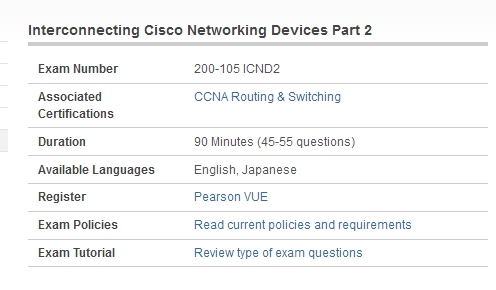
Pass4itsure Latest and Most Accurate Cisco 200-105 Dumps Exam Q&As:
Question No : 16 – (Topic 1) Which protocol provides a method of sharing VLAN configuration information between two Cisco switches?
A. STP
B. VTP
C. 802.1Q
D. RSTP
200-105 exam Answer: B
Explanation:
Understanding VLAN Trunk Protocol (VTP)
Introduction
VLAN Trunk Protocol (VTP) reduces administration in a switched network. When you configure a new VLAN on one VTP server, the VLAN is distributed through all switches in the domain. This reduces the need to configure the same VLAN everywhere. VTP is a Cisco-proprietary protocol that is available on most of the Cisco Catalyst series products.
Question No : 17 – (Topic 1) Which three statements are typical characteristics of VLAN arrangements? (Choose three.)
A. A new switch has no VLANs configured.
B. Connectivity between VLANs requires a Layer 3 device.
C. VLANs typically decrease the number of collision domains.
D. Each VLAN uses a separate address space.
E. A switch maintains a separate bridging table for each VLAN.
F. VLANs cannot span multiple switches.
Answer: B,D,E
Explanation:
By default, all ports on a new switch belong to VLAN 1 (default & native VLAN). There are also some well-known VLANs (for example: VLAN 1002 for fddi-default; VLAN 1003 for token-ring…) configured by default -> A is not correct. To communicate between two different VLANs we need to use a Layer 3 device like router
or Layer 3 switch -> B is correct. VLANs don’t affect the number of collision domains, they are the same -> C is not correct. Typically, VLANs increase the number of broadcast domains.We must use a different network (or sub-network) for each VLAN. For example we can use 192.168.1.0/24 for VLAN 1, 192.168.2.0/24 for VLAN 2 -> D is correct. A switch maintains a separate bridging table for each VLAN so that it can send frame to ports on the same VLAN only. For example, if a PC in VLAN 2 sends a frame then the switch look-ups its bridging table and only sends frame out of its ports which belong to VLAN 2 (it also sends this frame on trunk ports) -> E is correct. We can use multiple switches to expand VLAN -> F is not correct.
Question No : 18 – (Topic 1) Which two states are the port states when RSTP has converged? (Choose two.)
A. discarding
B. listening
C. learning
D. forwarding
E. disabled
200-105 dumps Answer: A,D
Explanation:
Understanding Rapid Spanning Tree Protocol (802.1w)
Port States
There are only three port states left in RSTP that correspond to the three possible operational states. The 802.1D disabled, blocking, and listening states are merged into a unique 802.1w discarding state. RSTP only has 3 port states which are discarding, learning and forwarding. When RSTP has converged there are only 2 port states left: discarding and forwarding.
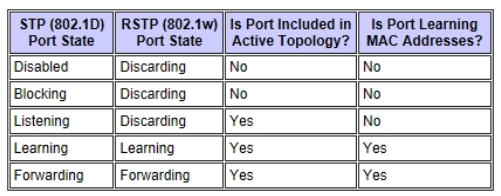
Question No : 19 – (Topic 1) Refer to the exhibit.
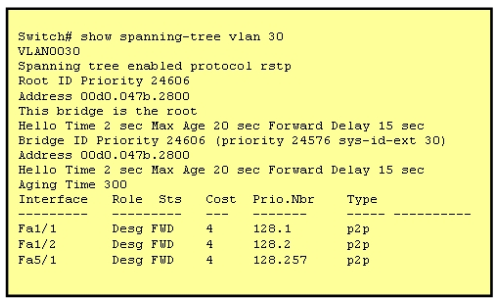
The output that is shown is generated at a switch. Which three statements are true? (Choose three.)
A. All ports will be in a state of discarding, learning, or forwarding.
B. Thirty VLANs have been configured on this switch.
C. The bridge priority is lower than the default value for spanning tree.
D. All interfaces that are shown are on shared media.
E. All designated ports are in a forwarding state.
F. This switch must be the root bridge for all VLANs on this switch.
Answer: A,C,E
Explanation:
From the output, we see that all ports are in Designated role (forwarding state) -> A and E are correct. The command “show spanning-tree vlan 30 only shows us information about VLAN 30. We don’t know how many VLAN exists in this switch -> B is not correct. The bridge priority of this switch is 24606 which is lower than the default value bridge
priority 32768 -> C is correct. All three interfaces on this switch have the connection type “p2p”, which means Point-to point environment – not a shared media -> D is not correct. The only thing we can specify is this switch is the root bridge for VLAN 3o but we can not guarantee it is also the root bridge for other VLANs -> F is not correct.
Question No : 20 – (Topic 1) Which port state is introduced by Rapid-PVST?
A. learning
B. listening
C. discarding
D. forwarding
200-105 pdf Answer: C
Explanation:
Spanning Tree from PVST+ to Rapid-PVST Migration Configuration Example
Reference 1:
Reference 2:
PVST+ is based on IEEE802.1D Spanning Tree Protocol (STP). But PVST+ has only 3 port states (discarding, learning and forwarding) while STP has 5 port states (blocking, listening, learning, forwarding and disabled). So discarding is a new port state in PVST+.
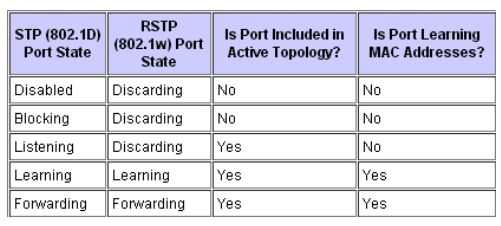
Background Information
802.1D Spanning Tree Protocol (STP) has a drawback of slow convergence. Cisco Catalyst switches support three types of STPs, which are PVST+, rapid-PVST+ and MST. PVST+ is based on IEEE802.1D standard and includes Cisco proprietary extensions such as BackboneFast, UplinkFast, and PortFast. Rapid-PVST+ is based on IEEE 802.1w
standard and has a faster convergence than 802.1D. RSTP (IEEE 802.1w) natively includes most of the Cisco proprietary enhancements to the 802.1D Spanning Tree, such as BackboneFast and UplinkFast. Rapid-PVST+ has these unique features: Uses Bridge Protocol Data Unit (BPDU) version 2 which is backward compatible with the
802.1D STP, which uses BPDU version 0. All the switches generate BPDUs and send out on all the ports every 2 seconds, whereas in 802.1D STP only the root bridge sends the configuration BPDUs.
Port Roles—Root port, designated port, alternate port and backup port.
Port States—Discarding, Learning, and Forwarding.
Port Types—Edge Port (PortFast), Point-to-Point and Shared port.
Rapid-PVST uses RSTP to provide faster convergence. When any RSTP port receives legacy 802.1D BPDU, it falls back to legacy STP and the inherent fast convergence benefits of 802.1w are lost when it interacts with legacy bridges.
Question No : 21 – (Topic 1) Refer to the exhibit.
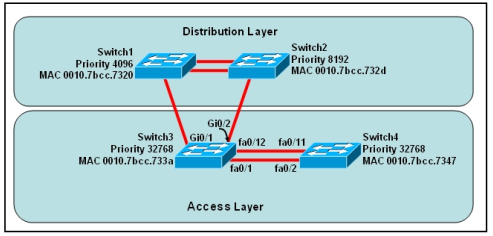
At the end of an RSTP election process, which access layer switch port will assume the discarding role?
A. Switch3, port fa0/1
B. Switch3, port fa0/12
C. Switch4, port fa0/11
D. Switch4, port fa0/2
E. Switch3, port Gi0/1
F. Switch3, port Gi0/2
Answer: C
Explanation:
In this question, we only care about the Access Layer switches (Switch3 & 4). Switch 3 has a lower bridge ID than Switch 4 (because the MAC of Switch3 is smaller than that of Switch4) so both ports of Switch3 will be in forwarding state. The alternative port will surely belong to Switch4. Switch4 will need to block one of its ports to avoid a bridging loop between the two switches. But how does Switch4 select its blocked port? Well, the answer is based on the BPDUs it receives from Switch3. A BPDU is superior than another if it has:
1. A lower Root Bridge ID2. A lower path cost to the Root3. A lower Sending Bridge ID4. A lower Sending Port ID
These four parameters are examined in order. In this specific case, all the BPDUs sent by Switch3 have the same Root Bridge ID, the same path cost to the Root and the same Sending Bridge ID. The only parameter left to select the best one is the Sending Port ID (Port ID = port priority + port index). In this case the port priorities are equal because they
use the default value, so Switch4 will compare port index values, which are unique to each port on the switch, and because Fa0/12 is inferior to Fa0/1, Switch4 will select the port connected with Fa0/1 (of Switch3) as its root port and block the other port -> Port fa0/11 of Switch4 will be blocked (discarding role)
QUESTION 22:
Which of the following is not a disadvantage of a bus topology network?
A. Difficult to troubleshoot
B. Expensive to implement
C. Attenuation
D. Signal interference
200-105 exam Answer:
QUESTION 23:
Which of the following are advantages of a bus topology?
A. Easy to troubleshoot failures
B. Failures are always limited to a single node
C. Inexpensive to implement
D. No network congestion
Answer:
QUESTION 24:
The acronym CSMA stands for:
A. Call signal multiple access.
B. Carrier sense multiple access.
C. Call signal message active.
D. Carrier sense message active.
200-105 dumps Answer:
QUESTION 25:
Ethernet LANs use which of the following?
A. CSMA/CA
B. CSMA/CD
C. Token passing
D. Token bus
Answer:
QUESTION 26:
CSMA/CD is based on which IEEE standard?
A. 802.3
B. 802.4
C. 802.5
D. 802.6
200-105 pdf Answer: A
QUESTION 27:
The star topology is different from buses and rings in that:
A. All data flows through a central hub.
B. Data never passes through a single central point.
C. The star topology allows only limited network control.
D. The star topology is harder to expand.
Answer: A
QUESTION 28:
Which of the following can be used to connect nodes to the network in a star topology?
A. Transceivers
B. Multistation access units
C. Switches
D. Access point
200-105 vce Answer:
QUESTION 29:
Which of the following represents a single point of failure in a star topology?
A. Backbone cable
B. Hub
C. Transceiver
D. Nodes
Answer:
QUESTION 30:
Ring topologies almost always use:
A. Token passing.
B. CSMA/CD.
C. CSMA/CA.
D. Token sharing.
200-105 exam Answer: A
QUESTION 31:
Like the physical bus topology, the physical ring topology:
A. Joins a single cable to form a continuous loop.
B. Connects all nodes along a single cable.
C. Uses a central concentrator.
D. Does not broadcast signals.
Answer:
QUESTION 32:
The 802.5 IEEE standard defines the operation of which topology?
A. Token bus
B. Token ring
C. Bus
D. Star
Answer: B
QUESTION 33:
Token ring networks operate according to the rules of which IEEE standard?
A. 802.3
B. 802.4
C. 802.5
D. 802.6
200-105 dumps Answer: C
QUESTION 34:
Ethernet 10BaseT is designed to use which physical topology?
A. Bus
B. Ring
C. Star
D. Tree
Answer: B
QUESTION 35:
Which of the following topologies is an expansion of the bus topology suitable for broadband transmissions?
A. Ring
B. Star
C. Mesh
D. Tree
200-105 pdf Answer:
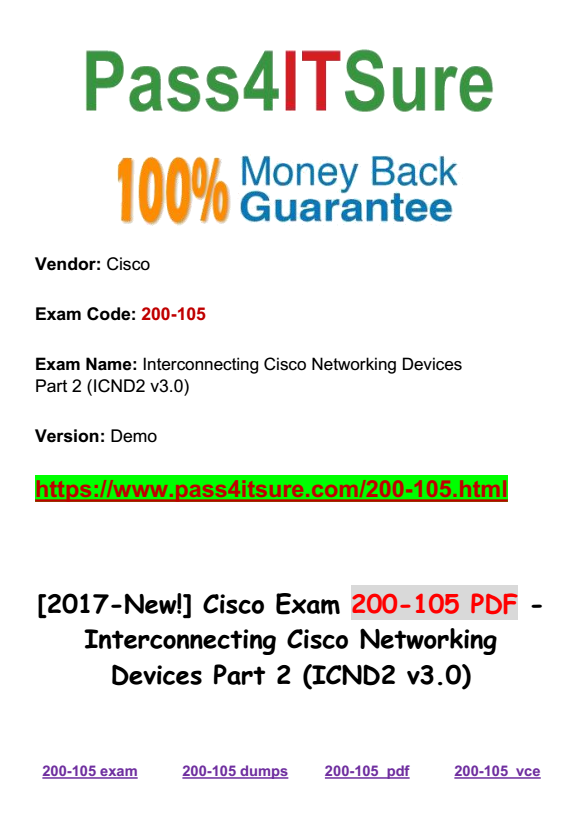
The Cisco Certified Network Associative Routing & Switching Certification covers the Cisco Networking Technology topics. The Cisco 200-105 dumps Interconnecting Cisco Networking Devices Exam allows students to understand and realize the benefits of Certification Area. Students who complete https://www.pass4itsure.com/200-105.html dumps ICND2 2 may get Cisco Certified Network Associative Routing & Switching Certification.